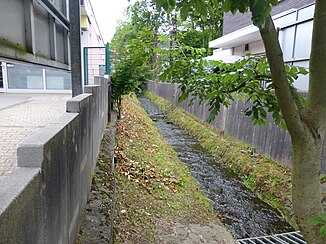Leimbach (Wupper)
| Leimbach | ||
|
The Leimbach at the level of Schützenstrasse |
||
| Data | ||
| Water code | DE : 2736513164 | |
| location | Wuppertal , North Rhine-Westphalia , Germany | |
| River system | Rhine | |
| Drain over | Wupper → Rhine → North Sea | |
| source | in the district of Barmer Hatzfeld 51 ° 17 ′ 36 ″ N , 7 ° 11 ′ 36 ″ E |
|
| Source height | 294 m above sea level NN | |
| muzzle | in the Barmer Mühlengraben Coordinates: 51 ° 16 ′ 16 " N , 7 ° 11 ′ 45" E 51 ° 16 ′ 16 " N , 7 ° 11 ′ 45" E |
|
| Mouth height | 154 m above sea level NN | |
| Height difference | 140 m | |
| Bottom slope | 43 ‰ | |
| length | 3.3 km | |
| Catchment area | 2.618 km² | |
|
Tributaries and hydraulic structures
|
||||||||||||||||||||||||||||||||||||||||||||||||||||||||||||||||||||||||||||||||||||
The Leimbach is a 3.271 km long brook in the Wuppertal district of Barmen . The stream, a tributary of the Wupper , is also the namesake for the streets called Leimbacher Straße and In der Leimbach .
etymology
The etymological origin of the Leimbach comes from the Low German word Lembeck and is explained by iron-containing water.
topography
The brook has its source near the former Flanhard estate in an industrial area around 283 meters above sea level on the northern heights of Wuppertal in the Hatzfeld district of Barm near the city limits of Sprockhövel . The watershed between Wupper and Ruhr also runs here . The first 180 meters of the stream runs piped in a southerly direction within the industrial park.
In the “Riescheid tramway cut”, which is also protected as a geological natural monument by Wuppertal, it comes to the surface and flows through a large bend . This bend belongs to the route of the Loh – Hatzfeld railway line , which interrupted the natural course of the stream through its construction. Since the construction of the cut, the Leimbach has followed the railway line.
Around 700 meters behind the source, the Lehmbeck inlet on the left joins the Leimbach stream. After around 900 meters, the Einerngraben , the lower remainder of the original stream before the construction of the railway line, joins it on the right and the Leimbach runs again for around 100 meters in a south-westerly direction past Riescheid . The Riescheid farm, which was formerly located there, was one of the earliest settlements in Barmen and was first mentioned in 1466.
From here it follows north of the elevation on which the Barmer Nordpark lies. After it has been piped up again, it joins the Gelber Sprung brook about 1.6 kilometers after the source (so called because of its iron-rich water, the surrounding sports fields bear the name of the source) and flows back south and undercuts thereby the federal highway 46 . At the western border of the elevation, the Leimbach, which now flows superficially again, turns again in a south-easterly direction. At this point there used to be a pond that was filled in around 1918, the area that is today on the In der Leimbach street (named October 1885) is built over as an industrial area. The Leimbach farm , which was mentioned as early as 1466, was also located here. The hamlets Obere and Untere Lembeck that emerged from this have risen up in the inner-city area since the beginning of the 20th century.
Around 2.2 kilometers after the source, the Leimbach continues piped again and is fed by the stream on Zietenstrasse . Before the Sedansberg , it turns again in a southerly direction below the course of Leimbacher Straße (recorded for the first time in the address book in 1871/72) until the course of Steinweg is reached. Below the Steinweg , the Leimbach continues in a southerly direction until it flows into the Mühlengraben at around 157 meters above sea level , a branch of the Wupper that is now built over.
The brook as a historical borderline
In the Middle Ages, the border between the electoral Cologne (later Brandenburg ) parish of Schwelm , which separated it from the Bergish parish of Elberfeld , ran along the Leimbach and its source stream Gelber Sprung . At the same time, this border separated the deanery Lüdenscheid from the deanery Deutz and the two Gogerichtsbezirke Schwelm and Elberfeld . This border still exists today in the dividing line between Oberbarmen and Unterbarmen (Niederbarmen). This border was secured in the late Middle Ages by a Landwehr that ran from Horath via Hatzfeld, along the Leimbach and Fischertaler Bach brooks and over the ridge of the Scharpenacker Mountains past Laaken to Beyenburg Castle .
Web links
Individual evidence
- ↑ a b German basic map 1: 5000
- ↑ a b c flow Geographic Information System of the Wupperverbandes
- ↑ a b Wolfgang Stock: Wuppertal street names . Thales Verlag, Essen-Werden 2002, ISBN 3-88908-481-8
